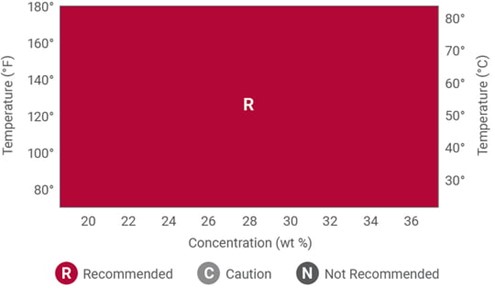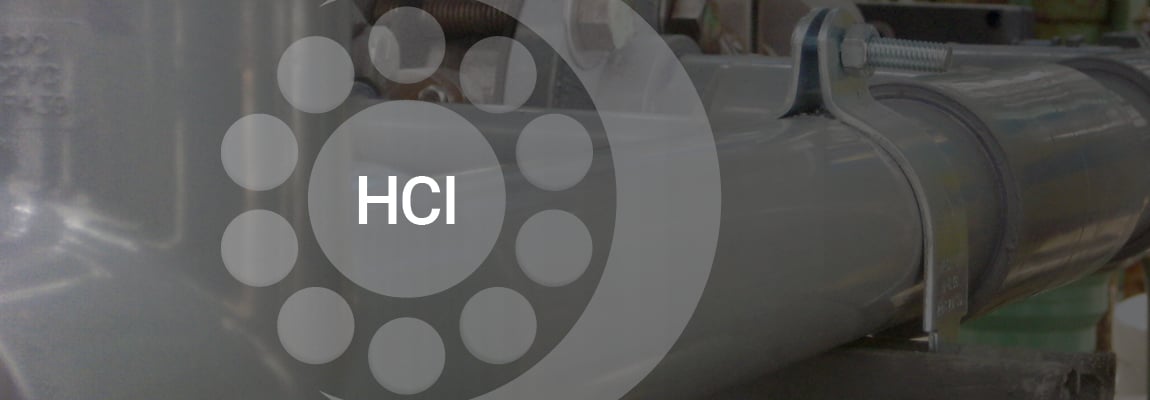Reliable Hydrochloric Acid Performance for Chlor-Alkali Plants
Chlor-alkali plants are among the most corrosive industrial environments. To produce harsh chemicals like caustic soda and chlorine gas, they use electricity and even harsher chemicals like hydrochloric acid. Hydrochloric acid is an important pH adjustment chemical used to prepare and treat brine prior to the electrolysis reaction in the chlor-alkali process. Therefore, extra care must be taken when specifying every material in the plant.
Due to the nature of the chemicals being processed and produced, most chlor-alkali plants opt to use non-metallic piping or high-end metals like stainless steel. For added structural stability, some also turn to fiberglass reinforced polymer lined piping.
In addition to selecting piping materials resistant to the chemicals moving through them, chlor-alkali plants must also select the same for tanks which are also exposed to these harsh chemicals. They can use a variety of traditional materials and liners in the market – or they can choose a single material that equally protects these parts of chlor-alkali plants from harsh chemicals like hydrochloric acid.
Corzan® CPVC reliably and safely performs against hydrochloric acid and other chemicals without the need for costly installation and replacement like stainless steel in certain areas of a chlor-alkali plant. Here’s where, how and why Corzan CPVC is used in chlor-alkali plants.
Corzan CPVC Schedule 80 Piping Systems
Corzan CPVC is recommended for use with hydrochloric acid in all concentrations for ambient temperatures (73°F/22.7°C) up to 180°F (82°C).

Corzan CPVC’s Chemical Resistance Table contains compatibility data for over 500 chemicals and compounds. This chart shows that hydrochloric acid is recommended for use with Corzan CPVC up to 180°F (82°C) at all concentrations.
Corzan CPVC’s physical properties help it resist corrosive chemicals like hydrochloric acid. The additional chlorine atoms on the polymer chain strengthen CPVC at the molecular level and make it chemically resistant to corrosion. Corzan CPVC’s additives, formulation and traceability make it the superior CPVC choice on the market.
Dual-Laminate CPVC Pipe with Fiberglass-Reinforced Polymer (FRP) Wrap
Some chlor-alkali manufacturers prefer to dual laminate or wrap their Corzan CPVC pipes with FRP to increase their mechanical strength for additional safety. By wrapping pressure-rated Corzan CPVC piping with FRP, the pipe gets added structural reinforcement, an extended heat deflection temperature (HDT) and greater impact resistance.
Dual-laminate piping can also mean significant cost savings and increased safety. The metals needed to survive hydrochloric acid, like titanium, nickel alloys or high-grade stainless steel, are around three times the cost of Corzan CPVC.
Tank Lining
Chlor-alkali plants depend on resilient chemical storage and processing tanks to remain safe and efficient. Lining steel, alloy or fiberglass tanks with Corzan CPVC sheet gives them corrosion resistance inside with rigidity outside. It also makes the tank easier to repair when problems occur, rather than requiring full replacement. This significantly reduces downtime and maintenance costs.
This is why fabricator Tri-Chlor trusts Corzan CPVC for its dual-laminate tank lining, especially in chlor-alkali plants.
Corzan CPVC Reliably Handles Hydrochloric Acid
Chlor-alkali plants handle some of the harshest, most corrosive chemicals. When properly specified and installed, Corzan CPVC can provide reliable, long-lasting resistance to hydrochloric acid. From standard pipe, dual-laminate pipe and tank lining for hydrochloric acid to tower packings and exhaust ducting for wet chlorine, Corzan CPVC is up to the challenge.
Hydrochloric acid is one of the Top 10 Chemicals that Corzan CPVC is more suitable for when compared with metal and other plastic. Learn more about Corzan CPVC and hydrochloric acid.

